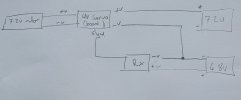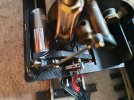DGE-Railroad
The Orchard Line
Could I check something with the electonics whizzes on here please?
I have a live steam loco with an antiquated RC system, the loco electronics (sound and lights) and the R/C are integrated at present and run off a 7.2v battery.
I intend to replace the receiver so I can use the same transmitter I use for my other locos. Others have already had success going this route - put in a new RX, strip the decoder boards out of donor servos and wire the servo board outputs into the loom for the existing motors for the speed regulator and valve control.
The issue I have is that 7.2v. That's high(er) voltage receiver and servo territory. I need to keep those motors supplied with 7.2v or they're going to be really slow.
The donor servos I'm using are high voltate so can pass the 7.2v without issue. The only receivers that will bind with my transmitter though, are the lower 4.8v type.
So....
Am I correct in thinking I can supply 4.8v to the RX, keep the signal wires from the RX going to the servo boards, but split out the servo board power and take that straight from the OEM 7.2v battery?
Logic tells me that should be fine. Can anyone confirm it?
I have a live steam loco with an antiquated RC system, the loco electronics (sound and lights) and the R/C are integrated at present and run off a 7.2v battery.
I intend to replace the receiver so I can use the same transmitter I use for my other locos. Others have already had success going this route - put in a new RX, strip the decoder boards out of donor servos and wire the servo board outputs into the loom for the existing motors for the speed regulator and valve control.
The issue I have is that 7.2v. That's high(er) voltage receiver and servo territory. I need to keep those motors supplied with 7.2v or they're going to be really slow.
The donor servos I'm using are high voltate so can pass the 7.2v without issue. The only receivers that will bind with my transmitter though, are the lower 4.8v type.
So....
Am I correct in thinking I can supply 4.8v to the RX, keep the signal wires from the RX going to the servo boards, but split out the servo board power and take that straight from the OEM 7.2v battery?
Logic tells me that should be fine. Can anyone confirm it?


